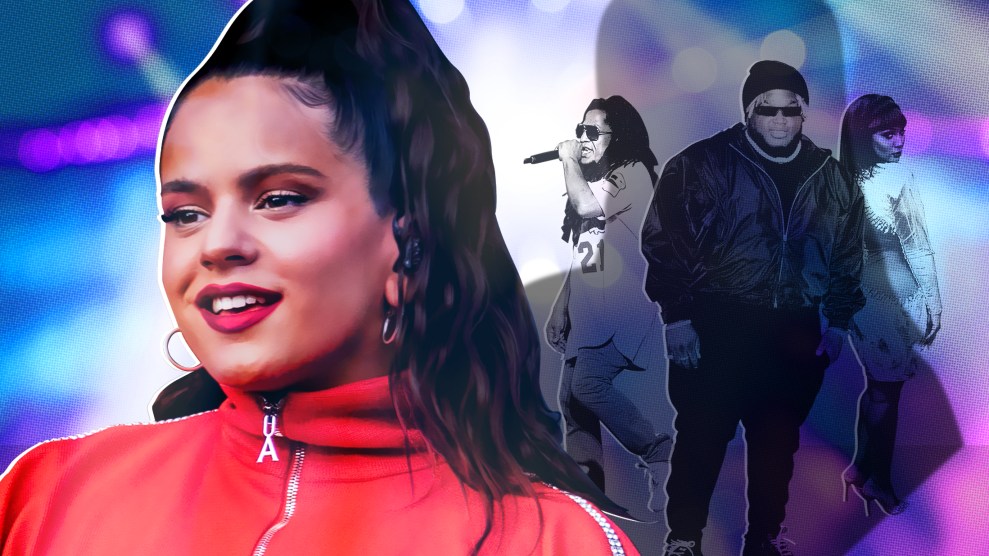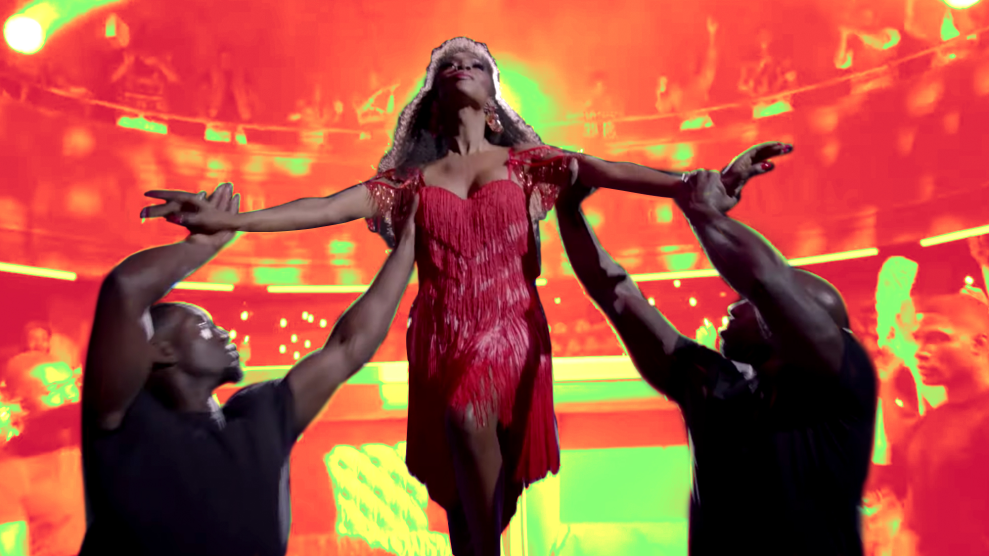
Mother Jones illustration
Flamenco singer Rosalía’s rise to global superstardom has felt almost instantaneous. Since her acclaimed and controversial sophomore album El Mal Querer dropped in November 2018, the 26-year-old artist, whose full name is Rosalía Vila Tobella, has skyrocketed out of the Spanish underground into full-fledged pop stardom in less than a year. When the 2019 Latin Grammy nominations were announced in late September, she was among this year’s top nominees, and she went on to clinch the Album of the Year and Best Urban Song, along with three other awards, at the ceremony in November.
In August, Rosalía became the first Catalan artist in MTV’s Video Music Award history to win multiple awards, snatching trophies for Best Choreography and Best Latin video for her hit “Con Altura.” “I come from Barcelona,” Rosalía said while accepting the VMA for Best Latin video. “I’m so happy to be here…representing my culture.”
That acceptance speech earned Rosalía a strong side-eye from some viewers. As Afro-Dominican journalist Jennifer Mota put it: “What part of ‘Con Altura’ was Rosalía’s culture, exactly?”
“Con Altura” is a reggaeton banger featuring Colombian superstar J Balvin and Spanish producer Pablo “El Guincho” Díaz-Reixa. The song showcases Rosalía’s beautiful, airy voice and distinct Spanish pronunciations over a classic Dembow beat—a rhythm that originated in Jamaica and then made its way throughout the African diaspora to places like Panama, New York City, Puerto Rico, and the Dominican Republic. Dembow is the foundation of reggaeton, a genre of music created in large part by Afro-Latinx people.
While Rosalía’s wildly popular song draws heavily from Afro-Caribbean music traditions, the artist herself has no Latin American heritage—a fact that has sparked cries of cultural appropriation from many Latinx fans. Since the artist’s catapult into the upper-crust of Latin music over the past year, a debate about race, class, privilege, and who gets to be considered Latinx has followed close behind.
A PSA FOR MY NON-LATINX BUT WELL-INTENTIONED GAYS:
Not every person who sings in Spanish (or who is featured on a Reggaeton track) is Latina/o/x.
Rosalía is from Spain. Not Latin America. You can like her without trying to use the word "Latina" as an inaccurate catchall.
— Gabe Gonzalez (@gaybonez) July 27, 2019
At times, Rosalía seems oblivious to these critiques. In January, the singer sat down for Billboard’s Growing Up Latino series and claimed to “feel Latina” when visiting Panama and Mexico. In August, she graced the cover of Vogue Mexico for an issue meant to highlight “20 Latino Artists making the world dance.”
Rosalía first heard the term con altura, which roughly translates to “doing something with style or elegance,” while searching for samples on YouTube. She stumbled upon a clip from the Dominican TV show Sábado Extraordinario in which Dominican radio host, Mariachi Budda, utters the phrase. Rosalía and her producers loved it so much they ripped Budda’s voice from the clip and placed it at the top of the song (Budda is credited as one of the song’s writers). “Con Altura,” which debuted in March, has since become Rosalía’s biggest commercial hit. It’s her most streamed song on Spotify, most-watched video on YouTube (with almost 1 billion views), and it earned her a Latin Grammy nod for Best Urban Song, securing her spot as this year’s most-nominated woman.
The song also marks a shift in Rosalía’s sound, moving her away from the stylized flamenco pop that characterized El Mal Querer toward more Caribbean sounds. That she’d be drawn to “Urbano” music isn’t completely surprising: While reggaeton had been frowned upon for years, deemed lower-class and even dangerous when it was still very black, the genre is now mainstream, lucrative, and a whole lot whiter. As Rosalía moves to embrace the genre’s newfound popularity, Mota says, “I think she has a social responsibility to analyze how much space she’s taking up in a black-rooted genre.”
Petra Rivera-Rideau, an assistant professor of American Studies at Wellesley College and author of Remixing Reggaeton: The Cultural Politics of Race in Puerto Rico, says Rosalía’s ascendance within the Latin mainstream follows a well-established precedent. “Of course, this is not unique to the Latin music industry, but there’s a pattern in Latin music where the industry promotes artists that are white even if the musical practices that they’re performing are rooted in black communities,” Rivera-Rideau says. “The people who are getting promoted to be at the higher echelons of these media industries, like popular music, tend to be Latinos who embody a kind of whiteness. It’s a distinct whiteness from the US. It’s not this idea of a pure whiteness, but it’s a mestizo whiteness.”
Rivera-Rideau says this “mestizo whiteness” is something media scholars dub the “Latin Look”: Someone with a light complexion, European features, and dark, wavy hair who could be mixed race, but not obviously black or indigenous. Someone who looks a lot like Rosalía or Enrique Iglesias or Alejandro Sanz—other Spanish artists who have also been mislabeled as Latinx.
It isn’t just their phenotype that makes Spanish artists profitable for Latin music companies. It’s also about the class position they enjoy by nature of being from a European country. While a Puerto Rican artist like Daddy Yankee might embody the Latin Look, Rivera-Rideau explains, he is still marked by a specific “urban mythology.” “He was still from the caserio (public housing). He has this whole story of getting shot in the leg,” Rivera-Rideau says. “As reggaeton moves forward and pushes into the pop mainstream, you have these sorts of more respectable kind of people performing this music. People who are seen as more safe.”
One of the reasons the media continues to misidentify Spanish artists as Latinx is that the language used to name people with Latin American roots has always been fraught. Cristina Mora, a sociology professor at University of California–Berkeley and the author of Making Hispanics: How Activists, Bureaucrats, and Media Constructed a New American, says that it took at least 15 years for Latinx communities to establish one pan-ethnic term they could use on the United States Census.
“This is a long struggle,” Mora says. “In the 1960s, [community leaders] were being flown into these big [Census] meetings of Puerto Ricans and Mexicans in Washington to discuss the issue and everybody started fighting. Puerto Ricans started accusing Mexicans of wanting to take over, and both of these groups were saying that Cubans were of a different race.” Mora says some people preferred “brown,” while others argued that brown would include non-Latin American people. Others liked Latino, short for Latino Americano, while some thought it sounded too foreign. The group eventually settled upon Hispanic, a contentious compromise that grouped different communities from Latin America together around their most commonly shared language, Spanish, which also inadvertently grouped them together with their former colonizer, Spain.
Univision then began using the term on-air, hoping its Spanish-speaking audience would begin identifying as Hispanics so as to establish a “Hispanic buying power,” a term they could then use to sell ad space. The TV station and marketing companies began to attach certain symbols and images to who a Hispanic (and by extension Latino) person was. According to Mora’s research, that person was almost always non-Black, non-Caribbean, and Spanish speaking. This consistent centering of white and mestizx Latinx people helped to entrench stereotypical images of what we think of when we think of a Latinx person. These rigid stereotypes allow Spanish people to slip easily in and out of the identity in ways many black and indigenous Latinx folks cannot, by virtue of their race.
Mora sees the media’s tendency to call Spanish celebrities Latinx as no accident, given the large profit music companies and artists stand to make by appealing to Latinx consumers: According to analytics firm Nielsen, “Hispanic” buying power is expected to reach nearly $2 trillion by 2021. Mora also highlights that this pre-dates Rosalía: “Antonio Banderas, Penélope Cruz, Julio Iglesias—all of these are examples of turning to Spain to speak for Latinidad in a way that obscures the real historical impact of colonization, genocide, indigeneity, and Afro-Latino ancestry,” Mora says.
And while Latinx folks have always seen colonization as a clear distinguishing factor that links them to each other and separates themselves from Spain, Mora says their Spanish-speaking colonizer has always been in the background. “In many ways, the boundaries of who Latinos were have always included a funny connection to Spain,” Mora says. “Sometimes it was very straightforward and paternalistic like ‘we are Latinos because we all stem from the motherland, from La Madre Patria.'”
Even if Rosalía isn’t technically Latinx, by being positioned as the “it girl” of reggaeton music, she ultimately benefits from the same racial privilege many lighter-skinned Latinx people reap daily, often at the expense of their black and indigenous Latinx counterparts. “How is it that our culture allows for someone like her to be included, but Latinx folks who have a lived black or indigenous experience could never get centered?” wonders Janel Martinez, a Garifuna journalist and founder of the media site Ain’t I Latina?.
But it’s easy for Latinx people to police Latinidad when it comes to Rosalía. It’s easy to point at a Spaniard and shout “colonizer.” It’s much harder, though, for non-black and non-indigenous Latinx folks to channel that energy inward and analyze how we benefit from the same racial privilege Rosalía does. “[The Latinx people] who are policing Latinidad tend to be the ones that are centered regardless,” Martinez says. “Look at the Urbano and reggaeton movement. It now consistently centers those who are racialized as white.”
Reggaeton artists J Balvin, Maluma, Karol G, and Becky G all profit from and take up space in a genre that wouldn’t have been possible without black people. “People get caught up in this monolithic ‘We are all the same’ narrative,” Martinez says. “Those that are white or mestizo/mestiza Latinxs have a hard time pointing the finger at themselves because they don’t want to be found guilty of the things they perpetuate daily.”
The reluctance of white and mestizx Latinx folks to critically analyze how we benefit from colonial social hierarchies that continue to organize our lives today is part of the reason why many black and indigenous millennials of Latin American descent are no longer identifying as Latinx. Some of them are calling for the dismantling of Latinidad all together by circulating the hashtag #LatinidadIsCancelled. “This conversation revolving around Rosalía spawns from our generation unpacking and critically analyzing the terms we’re using when identifying ourselves, our culture, and our ethnic backgrounds,” Mota says, “which is linked to the music that it’s rooted in.”
Latinidad—you in danger, girl.
Black and indigenous millennials are starting to say #LatinidadIsCancelled. Here's why. #LatinxHeritageMonth pic.twitter.com/MofTmEEolS
— The Root (@TheRoot) September 26, 2019
In a story for The Fader in May, Rosalía offered up a vague response to concerns that she’s a Latinx culture vulture. “If Latin music is music made in Spanish, then my music is part of Latin music,” she said. “But I do know that if I say I’m a Latina artist, that’s not correct, is it? I’m part of a generation that’s making music in Spanish. So, I don’t know—in that sense, I’d prefer for others to decide if I’m included in that, no?”
It’s unclear why someone so proud of her Barcelona heritage won’t publicly state that she isn’t Latina. It’s entirely possible that as a young Catalan artist, she’s struggling to make sense of herself when confronting US notions of identity while simultaneously navigating an industry that has never carved out a specific lane for people like her. It’s also possible that after years of witnessing Spanish artists before her reap the ample material benefits that come along with feigning Latinidad, Rosalía wants her very own silver ticket to Potosí: Not just the top spot in the Latin music world but in the coveted US mainstream as well. Rosalía didn’t return my request for an interview for this story.
What is clear to Mota, however, is that if Rosalía wants to continue to make reggaeton music, she should, at the very least, do a better job acting as an ally for Afro-Latinx people. “Rosalía should be collaborating with black artists, with negras,” Mota says. “If you want to embrace reggaeton, embrace it with negras that are in the industry who don’t have the privilege to navigate certain spaces.”
*This story has been updated to reflect the outcome of the 2019 Latin Grammy awards.
Top image credits: Daniel DeSlover/Zuma; Regina Wagner/Future-Image/Zuma; Jose L. Cruz Cande/El Nuevo Dia/Zuma; Alexander Zayas/imageSPACE/Zuma; Getty
















